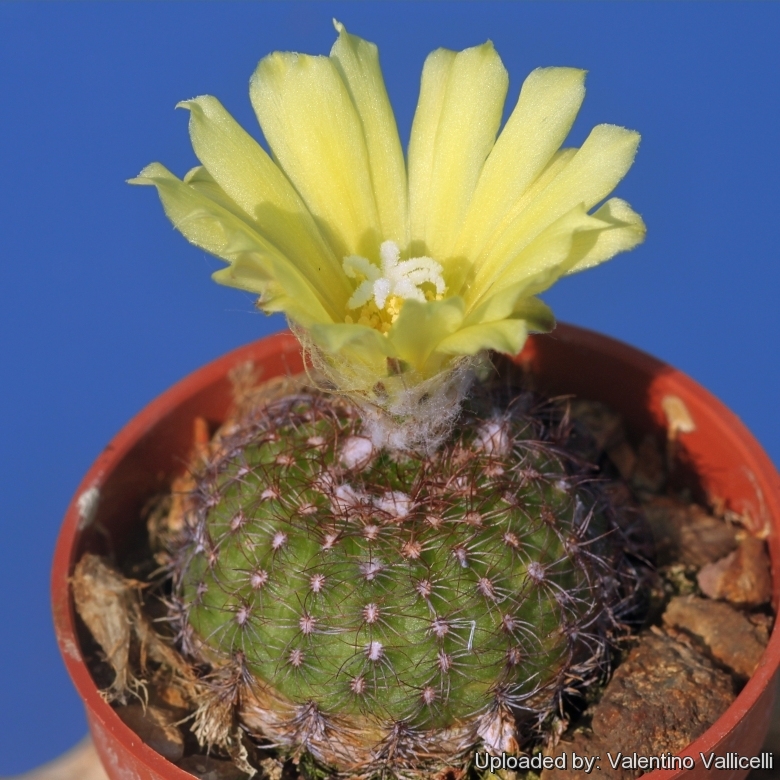
Frailea schilinzkyana Photo by: Valentino Vallicelli
Origin and Habitat: Frailea schilinzkyana has a relatively small range in Rio Grande do Sul (Brazil); Entre Rios, Corrientes, and Misiones provinces (Argentina); Paraguarí and Concepción departments (Paraguay) and in Uruguay.
Altitude: 150-500 metres above sea level.
Type locality: In Brazil it grows on grass plains, elsewhere mostly on rocky outcrops and stony fields. Frailea schilinzkyanaSN|3634]]SN|3634]] is not abundant and its distribution is sparse. In general, Frailea species have a relatively short lifespan but rapid reproduction (generation length is 3-5 years). The habitat of this cactus has a very high potential to be used for agriculture. The major threats are trampling by grazing cattle, agriculture, forestry (Eucalyptus plantations), and fire.
Synonyms:
See all synonyms of Frailea schilinzkyana
back
Accepted name in llifle Database:Frailea schilinzkyana (F.Haage ex K.Schum.) Britton & RoseCactaceae (Britton & Rose) 3: 210. 1922 [12 Oct 1922]Synonymy: 26
back
Description: Frailea schilinzkyanaSN|3634]]SN|3634]] is a very small cactus that remains solitary or (occasiaonally) somewhat cespitose.
Stem: It is diminutive in size, about 3 cm in diameter, depressed globular and somewhat flattened and umbilicate above, (wider than taller). Medium dark brownish green
Ribs: 10 to 13, but very indistinct, more or less spiraled, strongly tubercled
Areoles: Placed on the upper side of the tubercles.
Radial spines: About 12 to 14 short (2 to 3 mm long) which vary from yellow to dark tannish-brow n or blackish in colour, more or less appressed and reflexed.
Central spines: Solitary, stouter than the radials.
Roots: Fat central tap root.
Flowers: Yellow small, infundibuliform, often cleistogamous (Even when their flowers do not open, they still form fruits with many seeds)
Blooming season: Flowers will open only in great heat, in the hottest, brightest, afternoon sun, if at all.
Fruits: Dry, indehiscent, that detach easily, yellowish, pericarp membranous, fragile that break easily, releasing the seed.
Subspecies, varieties, forms and cultivars of plants belonging to the Frailea schilinzkyana group
 Frailea friedrichii Buining & Moser: stems solitary, dark green to coppery red, to 3-5 cm in diameter. Ribs 17-20, vertical, and forming tubercles. distribution: Cordillera and Paraguarí, Paraguay.
Frailea friedrichii Buining & Moser: stems solitary, dark green to coppery red, to 3-5 cm in diameter. Ribs 17-20, vertical, and forming tubercles. distribution: Cordillera and Paraguarí, Paraguay. Frailea grahliana (F.Haage) Britton & Rose
Frailea grahliana (F.Haage) Britton & Rose- Frailea grahliana subs. moseriana (Buining & Bredero) Prestlé
- Frailea ignacionensis Buining & G.Moser
 Frailea perumbilicata F.Ritter: has stems typically flattened and umbilicate above. Ribs usually 15. Radial spines 6-10, central spines usually absent. Distribution: Rio Grande do Sul, Brazil.
Frailea perumbilicata F.Ritter: has stems typically flattened and umbilicate above. Ribs usually 15. Radial spines 6-10, central spines usually absent. Distribution: Rio Grande do Sul, Brazil. Frailea schilinzkyana (F.Haage ex K.Schum.) Britton & Rose: has small stems (ca 3 cm Ø) depressed globular dark brownish green. Ribs 10-13 tubercled. Spines 12 to 14, yellow to dark tannish-brown 2 to 3 mm long. Distribution: Brazil), Argentina, Paraguay and Uruguay.
Frailea schilinzkyana (F.Haage ex K.Schum.) Britton & Rose: has small stems (ca 3 cm Ø) depressed globular dark brownish green. Ribs 10-13 tubercled. Spines 12 to 14, yellow to dark tannish-brown 2 to 3 mm long. Distribution: Brazil), Argentina, Paraguay and Uruguay. Frailea schilinzkyana f. cristata hort.: Crested form.
Frailea schilinzkyana f. cristata hort.: Crested form. Frailea ybatensis Buining & Moser: has less numerous spines, more numerous ribs, dark brownish-green or purple-violet stems, and citron yellow flowers. Distribution: Ytá-Ybaté, South East of Asunción, Paraguay.
Frailea ybatensis Buining & Moser: has less numerous spines, more numerous ribs, dark brownish-green or purple-violet stems, and citron yellow flowers. Distribution: Ytá-Ybaté, South East of Asunción, Paraguay.
Notes: Most fraileas are autogamous, or self-fertile to their own pollen and self-fertilization occurs in the closed flower. They produces viable seeds without the flower having opened. This phenomenon is called cleistogamy. The accepted opinion is that Frailea flowers only open in full sun, otherwise fruits will form cleistogamously. In reality relations are quite different: Both Frailea grahlianaSN|3610]]SN|3628]] and Frailea schilinskyana produce buds in the form of a miniature plant of barely 10 mm in section, which do not open but which may still become seed-bearing fruits. Only when the young plants grow larger and are amply surrounded with offsets, do buds develop which pass into open flowers. Plants having open flowers for the first time, also produce again in the following year (pre-supposing that growth continues in the same manner) a few cleistogamous flowers first and after that open flowers. Only when the plants are so large that they flower with open flowers right at the start of the season, does this ability apply to even the smallest offset. Frailea aurea, Frailea carminifilamentosa, Frailea pseudograhliana, and Frailea pumilia, behave in this same way. Larger-growing Fraileas such as Frailea bruchii, Frailea dadakiiSN|3628]]SN|3610]], Frailea pygmaea, which seldom make offsets, bear fewer flowers. Here again, open flowers only appear on older plants. For every standstill in growth, the plant answers with cleistogamous flowers - in the summer weather too. In the event of the standstill in growth occurring in spring - for instance owing to repotting - then open flowers only come in summer. This will have led to the wrong opinion, that Fraileas flowers only open in full sunshine.
Cleistogamous buds are initially conical, then shortly a change occurs in the bud development - that part of the bud at the base starts growing thicker and petals are never formed. The buds that form flowers grow a slender egg shape and open quite some time later. Under normal circumstances the flowers opens in the greenhouse at a temperature above 20°C. They stay open only a few hours around noon, and they do not open again the next day. It is of interest that most of the open flowers do not form seeds if, one does not assist by pollinating by hand.
[W. Simon “The behaviour of some cacti during fertilisation cleistogamy.” The Chileans '69 pp.18-20 Volume 3 Number 14 (Translated from Succulenta for May 1967 by H. Vriend) <http://www.grahamcharles.org.uk/Chileans%20editions/Issue14.pdf>]
Bibliography: Major references and further lectures
1) James Cullen, Sabina G. Knees, H. Suzanne Cubey “The European Garden Flora Flowering Plants: A Manual for the Identification of Plants Cultivated in Europe, Both Out-of-Doors and Under Glass” Cambridge University Press, 11/Aug./2011
2) David Hunt, Nigel Taylor “The New Cactus Lexicon” DH Books, 2006
3) Edward F. Anderson “The Cactus Family” Timber Press, 2001
4) Larocca, J., Machado, M., Kiesling, R., Oakley, L., Pin, A. & Duarte, W. 2013. Frailea schilinzkyana. In: IUCN 2013. "IUCN Red List of Threatened Species." Version 2013.2. <www.iucnredlist.org>. Downloaded on 09 January 2014.
5) W. Simon “The behaviour of some cacti during fertilisation cleistogamy.” The Chileans '69 pp.18-20 Volume 3 Number 14 (Translated from Succulenta for May 1967 by H. Vriend)
 Frailea schilinzkyana Photo by: Cactus Art
Frailea schilinzkyana Photo by: Cactus Art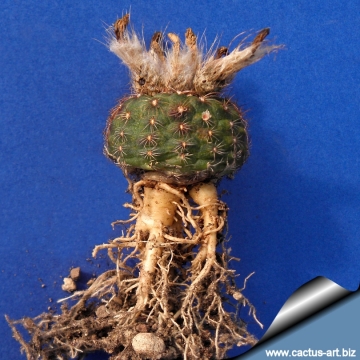 Frailea schilinzkyana Photo by: Cactus Art
Frailea schilinzkyana Photo by: Cactus Art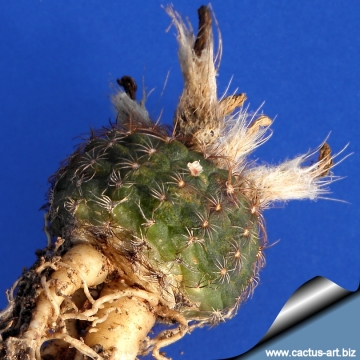 Frailea schilinzkyana Photo by: Cactus Art
Frailea schilinzkyana Photo by: Cactus Art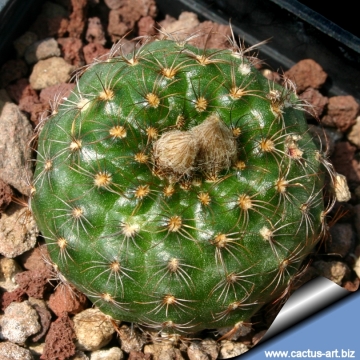 Frailea schilinzkyana Photo by: Cactus Art
Frailea schilinzkyana Photo by: Cactus Art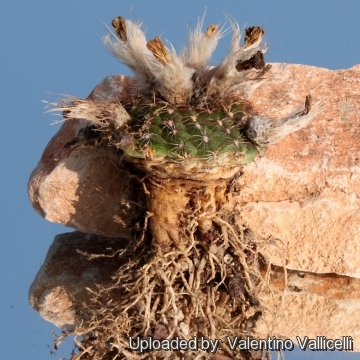 Frailea schilinzkyana Photo by: Valentino Vallicelli
Frailea schilinzkyana Photo by: Valentino Vallicelli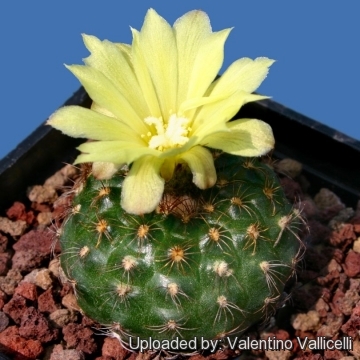 - On summer days one can admire the splendour of its beautiful yellow flower, larger than the plant itself. Photo by: Valentino Vallicelli
- On summer days one can admire the splendour of its beautiful yellow flower, larger than the plant itself. Photo by: Valentino VallicelliCultivation and Propagation: Fraileas are are tiny plants with comparatively big yellow flowers, often bigger than the whole plant itself and are especially suitable for those with limited growing space. They can be easily grown in a sunny windowsill or a small greenhouse. The secret for keeping Fraileas happy and growing is to pot them in a rich, porous soil with good drainage and aeration, to give them lots of water and let them dry out between waterings. Fraileas do like more water than most other cacti. If you over-pot them (in about 6-7 cm pots) they grow much better and healthier, as they can be quite short-lived if not given correct growing conditions. During winter they like cool and dry places (minimum temperature of 5-10° C) but even light frosts do not harms them. Characteristically, during the dry season plants retract completely under the ground, both in the wild and in cultivation too. Occasional light spray of water during the winter helps plants from shrivelling up too much. In the summer they like the pot to be filled with rainwater (which is always better to use than tap water) quickly absorbed by the plants, and one can almost see the little bodies swelling up. After a day or two, it is best to drain off any remaining water in the under-pots.
Sun Exposure: They enjoy full sun. In a shaded position the plants grow faster, but are not flat shaped or dark coloured.
Propagation: With fresh harvested seeds or (rarely) by grafting. The seeds germinates well. Sow the them on the soil surface, so that they can grow to a reasonable size before they have to be pricked out into a bigger tray. The seed trays go into a heated propagator on a windowsill where they catch the afternoon sun. It does not take long for the seeds to germinate, and some will do so within a day or two after sowing. When they have reached a height of about 1 cm they are pricked out into a larger tray, where they remain until they are large enough to go into individual pots.

















